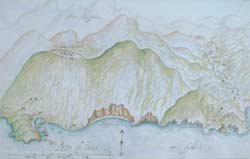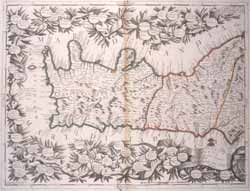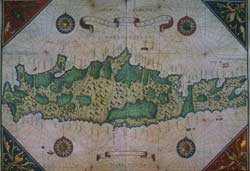Venetian traveller’s diaries
Religious travellers, pilgrims, traversed the Mediterranean from late Roman times onwards, and in some cases wrote diaries of their travels which record important (Christian) landmarks. Recording non-Christian monuments starts to take place in the fourteenth century with Cyriacus of Ancona in Italy, whose recording of now lost buildings and inscriptions in Greece and Turkey is still valuable to modern scholars.
 Plan by Onorio Belli of one of the Roman theatres at Gortyn (1586). © Aris and Phillips |
Crete did not lie on the usual pilgrim or antiquarian route, but from the fifteenth century onwards, a series of Venetian writers began to take a serious interest in all aspects of the island (which formed part of the Venetian empire until the mid-seventeenth century: see Unit 1 Session 3 Lesson 4). The earliest of these is Buondelmonti, who in 1415 wrote a description of the whole island. The interests of these Italians were very wide-ranging. For example, Onorio Belli (1550-1603), a physician from Vicenza near Venice, lived in the Aegean for some time. He recorded new plant species on Crete (some 71 species were collected in Khania and its environs), and also drew plans of Roman theatres in the eastern part of the island; as those theatres are now destroyed, the drawings, like those of Cyriacus, retain their value today.
 Painting by Monanni (1622) of Sphakia. © Biblioteca Marciana, Venice |
A full description of the whole island was instigated by the Venetians about 1538; it records many now-lost architectural remains of the Graeco-Roman period. Another tradition that began under Venice was of topographical drawings of particular places on Crete. Those by Monanni show a remarkable attention to detail; some by taking an imaginary aerial view (at 45 degrees) locate a series of settlements and individual buildings with great precision. The painting by Monanni, looking north, shows the coast between Loutro on the west and Khora Sphakion, with Venetian fort, on the east. In the centre is Glyka Nera (‘Acque dolci’) and above is Anopoli and ‘Pachi dicho’ = ‘Thick Wall’, i.e. of the ancient city. Askyphou (‘Aschifo’) at the top right. Springs are marked as ‘fontane’, e.g., at Phoinikas, west of Loutro. Another painting by Monanni will be found in Unit 3 Session 3.
Other paintings by Monanni will be found in Unit 3 Session 4, and Unit 4 Session 4.
 Map of western Crete by V. Coronelli (1650-1718), Cosmographer of Venice. © University Library, Cambridge |
Cartography was another tradition that had its roots in antiquity. Here the interests were stimulated not by imperialism, but by the needs of commerce. In antiquity there were listings of harbours and landing spots, with distances between them measured along the coasts.
 Map of Crete by Kalapodha (1562). |
There was also the great geographical treatise by Ptolemy, which added measurements in latitude. From these two traditions came the production by the early Mediaeval period of maps of Crete (and elsewhere). Some, like the ancient listings of harbours, were important to navigators, while others had a more 'scientific' ambition.
This cartographic interest was shared by the other great power of the period, the Ottomans (who captured Crete from the Venetians). The major scholar Piri Reis completed in 1526 a 'Book of the Sea' which was designed as a guide for the Ottoman fleet, but which also contained historical, archaeological and mythological data.